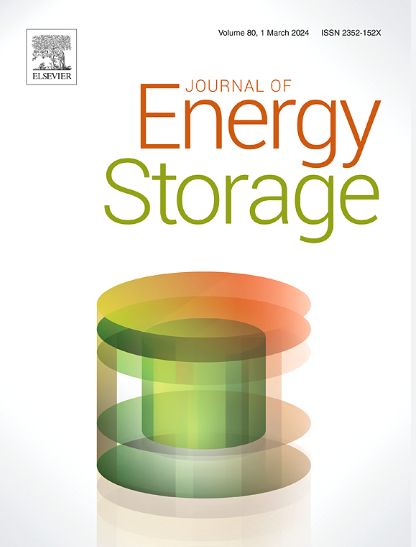基于Na2Ti3O7和Fe2O3的电化学钠离子存储层次化纳米复合材料的制备与表征
IF 8.9
2区 工程技术
Q1 ENERGY & FUELS
引用次数: 0
摘要
为了设计高性能的钠离子电池阳极,目前的关键任务是开发新材料和改进已知材料。本文介绍了一锅法制备三钛酸钠和氧化铁纳米复合材料的方法。在该方法中,TiO2和FeCl3在浓NaOH溶液中同时水热处理,形成由Na2Ti3O7纳米管和Fe2O3纳米球自组装的微尺度颗粒。首次研究了Na2Ti3O7-Fe2O3纳米复合材料作为钠离子电池的潜在负极材料。结果表明,在层次化结构中,将Na2Ti3O7与Fe2O3结合作为高容性改性剂可提高na离子的存储性能。在0.1C和4С下比容量分别达到220和50 mAh g−1。在相同的电流密度下,纯Na2Ti3O7只产生大约145和10 mAh g−1。此外,Na2Ti3O7 - Fe2O3纳米复合材料在1000次充放电循环中以2C的速率稳定运行,可逆容量为90 mAh g−1,而纯Na2Ti3O7和Fe2O3的长期性能较差。这些发现提高了我们如何结合不同材料的知识,以增强其作为钠离子电池阳极的应用功能。本文章由计算机程序翻译,如有差异,请以英文原文为准。
Hierarchical nanocomposite based on Na2Ti3O7 and Fe2O3 for electrochemical sodium ion storage: Preparation and characterization
A key task nowadays is the development of novel materials and the enhancement of known ones in order to design high-performance anodes for sodium-ion batteries. This article presents a one-pot method of preparing a nanocomposite with hierarchical structure based on sodium trititanate and iron(III) oxide. In this method, simultaneous hydrothermal treatment of TiO2 and FeCl3 in a concentrated NaOH solution results in the formation of microscale particles self-assembled of Na2Ti3O7 nanotubes and Fe2O3 nanospheres. A Na2Ti3O7–Fe2O3 nanocomposite is being investigated for the first time as a potential anode material for sodium-ion batteries. It was found that combining Na2Ti3O7 with Fe2O3 as a high-capacitive modifier within the hierarchical structure improves Na-ion storage performance. Its specific capacity reaches about 220 and 50 mAh g−1 at 0.1C and 4С, respectively. The pure Na2Ti3O7 gives only around 145 and 10 mAh g−1 at the same current densities. Besides, the Na2Ti3O7–Fe2O3 nanocomposite operates stably during 1000 charge/discharge cycles at a rate of 2C with a reversible capacity of 90 mAh g−1, whereas both pure Na2Ti3O7 and Fe2O3 exhibit worse long-term performance. These findings improve our knowledge of how to combine different materials in order to enhance their functionalities for application as an anode in sodium-ion batteries.
求助全文
通过发布文献求助,成功后即可免费获取论文全文。
去求助
来源期刊

Journal of energy storage
Energy-Renewable Energy, Sustainability and the Environment
CiteScore
11.80
自引率
24.50%
发文量
2262
审稿时长
69 days
期刊介绍:
Journal of energy storage focusses on all aspects of energy storage, in particular systems integration, electric grid integration, modelling and analysis, novel energy storage technologies, sizing and management strategies, business models for operation of storage systems and energy storage developments worldwide.
 求助内容:
求助内容: 应助结果提醒方式:
应助结果提醒方式:


